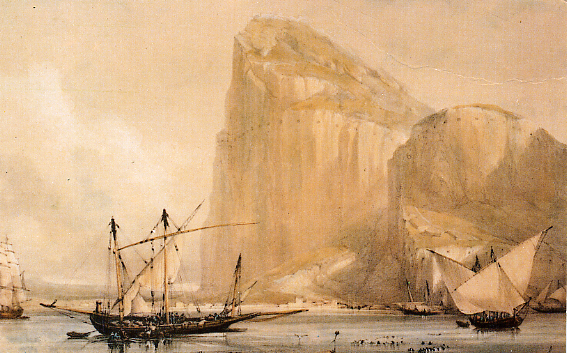On the 4th of August, 1809, Byron's arrived at the Rock of Gibraltar, the southern end of the peninsular, leaning north towards Andalusia, more precisely, the region of Sierra Morena. I'm not entirely sure about the location of Childe Harold in this particular stanza, but if he can see the Moorish turrets, which I'm assuming was the Moorish Castle constructed in the Marinid Dynasty.
 |
| The Rock of Gibraltar's North Front cliff face from Bayside (c.1810) showing the embrasures in the Rock. |
The Tower of Homage was the tallest construction during the Islamic period of the peninsular, and played a huge part in the conquest of Iberia. Interestingly, there are two architectures on the peninsular that could have been the Moorish Castle. One is, of course, the one in Gibraltar; the other one, is the Castle of the Moors in Sintra, Portugal. There are clear distinctions between the appearances of the two. One is the only Marinid construction outside of Africa, the other, well, a Medieval castle made of stones, overlooking Sintra from the mountains. Both of them, however, witnessed much of the sorrow of people whose homes were ruined, and countries taken over by a trail of different conquerors.
 |
| The Moorish Castle, Gibraltar by Terence Humphries |
In 1808, the year before Byron's visit, Ferdinand VII had been King of Spain. He was, well, the other potato head (apart from Godoy) that primarily caused most of Spain's suffering. Stanza 50 is about him, his colourful story of betrayal and rumors of his birth.
 |
| Portrait of Ferdinand VII by Goya |
Landscape cloaked by an atmosphere of war becomes an entirely different kind of scenery. It's as though every single turn of the mountain path, or the fog, or the plantation all become saturated with military strategies. Simple, innocent landscape, now every thread of it is woven with tension.
 |
| The Surrender at Bailén by José Casado del Alisal. Oil on canvas. Museo del Prado. |
In stanza 49, the dragon nest is actually Province of Jean where The Battle of Bailen took place. Spain had a so-called victory and it ended with the negotiated surrender of French occupiers. At the same time, hero stories of Spain also ignited the spirit in Austria, whose warriors defended their homeland against France with passion.
The spirit is up after the Battle of Bailen: it's no longer impossible to defeat Napoleon, says Spain, look what we've just done! Their victory was, of course, more of a temporary luck. Before long, Spain was once again almost completely lost to the Gaul, as Harold here "foreseeing" the bad omen coming down. Bear in mind that Byron wrote all this after his journey's done. He could make all of his political commentaries in Harold's name and call it speculations.




No comments:
Post a Comment